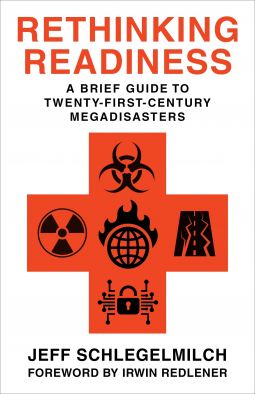A case for [Rethinking Readiness by Jeff Schlegelmilch].
As human society continues to develop, we have increased the risk of large-scale disasters. From health care to infrastructure to national security, systems designed to keep us safe have also heightened the potential for catastrophe. The constant pressure of climate change, geopolitical conflict, and our tendency to ignore what is hard to grasp exacerbates potential dangers. How can we prepare for and prevent the twenty-first-century disasters on the horizon?
Rethinking Readiness offers an expert introduction to human-made threats and vulnerabilities, with a focus on opportunities to reimagine how we approach disaster preparedness. Jeff Schlegelmilch identifies and explores the most critical threats facing the world today, detailing the dangers of pandemics, climate change, infrastructure collapse, cyberattacks, and nuclear conflict. Drawing on the latest research from leading experts, he provides an accessible overview of the causes and potential effects of these looming megadisasters. The book highlights the potential for building resilient, adaptable, and sustainable systems so that we can be better prepared to respond to and recover from future crises. Thoroughly grounded in scientific and policy expertise, Rethinking Readiness is an essential guide to this century’s biggest challenges in disaster management.
A cleverly worded tweet caught my attention and brought me to this book, linking in the current global pandemic and my desire for access to more books. Less than 200 pages long, my eBook copy of Jeff Schlegelmilch's Rethinking Readiness: A Brief Guide to Twenty-First-Century Megadisasters was exactly that, brief. What the book offers is a general overview and quick analysis of the approach to emergency preparedness, especially in the context of the United States. Historical examples of reactive approaches to disasters and the ongoing social vulnerabilities and lack of political impetus are explored as impediments to successful emergency preparedness. Disaster simulations are analyzed and the case for greater investment in emergency infrastructure is made.But the book is what the book purports to be, a brief guide to rethinking readiness. It's a case to be ready. Reading this book as we live through the gross federal mismanagements and oversights in response to the coronavirus pandemic is interesting. As many in the field have said in numerous interviews with news outlets and reporters, warnings and plans of response to a disaster like the one we're now trudging through had been available for years. And history will show how horribly politicians have failed us.
I enjoyed this book because I enjoy learning about emergency preparedness. I like to think about logistics and planning. I gained new insights on the ongoing threats to domestic cybersecurity and of global nuclear conflict. Unfortunately I don't feel I'm walking away from my read with a plan. Ironic. I walk away with grand notions and a stronger sense that, yes, emergency preparedness needs to be a forefront issue, always, but this book felt like a general case was being made.
Back to that tweet. Yes, the read in the context of corona was interesting, but I'm not rethinking anything I didn't generally already know. Yes, I would recommend this book, but to those nearly not at all verse with any concept of emergency preparedness and management. To the fools protesting confinement safety measures and willing to expose themselves and their communities at large, yes, I would suggest they read this book, but I really doubt they'd listen to me. So while I started this review thinking 3 stars, in the end this gets 4 stars from me.

Comments
Post a Comment